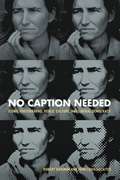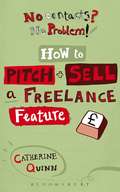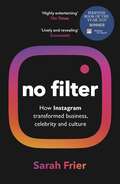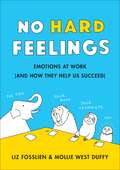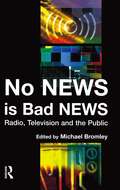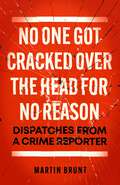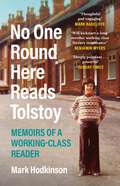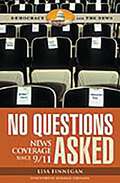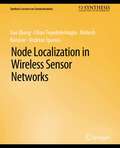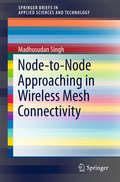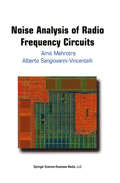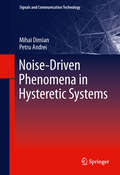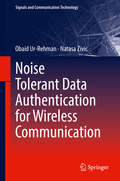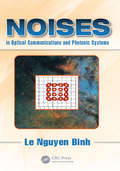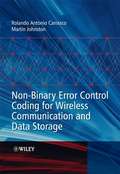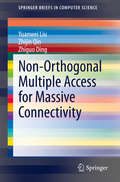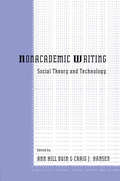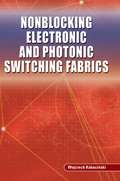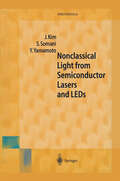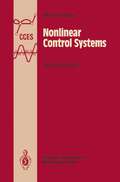- Table View
- List View
No Caption Needed: Iconic Photographs, Public Culture, and Liberal Democracy
by Robert Hariman John Louis LucaitesIn No Caption Needed, Robert Hariman and John Louis Lucaites provide the definitive study of the iconic photograph as a dynamic form of public art. Their critical analyses of nine individual icons explore the photographs themselves and their subsequent circulation through an astonishing array of media, including stamps, posters, billboards, editorial cartoons, TV shows, Web pages, tattoos, and more. Iconic images are revealed as models of visual eloquence, signposts for collective memory, means of persuasion across the political spectrum, and a crucial resource for critical reflection. Arguing against the conventional belief that visual images short-circuit rational deliberation and radical critique, Hariman and Lucaites make a bold case for the value of visual imagery in a liberal-democratic society. No Caption Needed is a compelling demonstration of photojournalism’s vital contribution to public life.
No contacts? No problem! How to Pitch and Sell a Freelance Feature
by Catherine QuinnThere are plenty of books on the market which tell you how to write stylish prose, attention-grabbing headlines or market yourself better as a freelance writer. But how do you get that first piece published in a national publication? This book shows you the techniques that real freelancers use to sell their ideas and get into print.Professional freelancer Catherine Quinn, who built a successful freelance career from scratch, guides you through a step-by-step process to get your first article in print, from how to format your pitch, to identifying the undersold freelance hotspots.Her tried and tested step-by-step approach:- Shows you how to scope the market and pick the most likely potential customers- Gives the inside track on how to convince editors who've never heard of you to commission your work- Tells you what to expect at every step along the pitching process- Includes a four week plan with a day-by-day process to kick start your freelance career
No contacts? No problem! How to Pitch and Sell a Freelance Feature: How To Pitch And Sell A Freelance Feature
by Catherine QuinnThere are plenty of books on the market which tell you how to write stylish prose, attention-grabbing headlines or market yourself better as a freelance writer. But how do you get that first piece published in a national publication? This book shows you the techniques that real freelancers use to sell their ideas and get into print.Professional freelancer Catherine Quinn, who built a successful freelance career from scratch, guides you through a step-by-step process to get your first article in print, from how to format your pitch, to identifying the undersold freelance hotspots.Her tried and tested step-by-step approach:- Shows you how to scope the market and pick the most likely potential customers- Gives the inside track on how to convince editors who've never heard of you to commission your work- Tells you what to expect at every step along the pitching process- Includes a four week plan with a day-by-day process to kick start your freelance career
No Filter: The inside story of how Instagram transformed business, celebrity and our culture
by Sarah Frier‘Deeply researched and highly entertaining.’ The Times‘Vivid reporting and electric story-telling.’ Ashlee Vance, author of Elon Musk‘Clear-eyed and objective.’ New York Times The extraordinary inside story of how Instagram became the world’s most successful appIn just ten years, Instagram has gone from being a simple photo app to a $100-billion company. The journey has involved ground-breaking innovations, a billion-dollar takeover, and clashes between some of the biggest names in tech. But it’s a story that has never been told – until now. In No Filter, Bloomberg’s Sarah Frier reveals how Instagram became the hottest app in a generation, reshaping our culture and economy in the process. With astonishing access to all the key players – from Instagram’s co-founders to super-influencers like Kris Jenner – Frier offers behind-the-scenes glimpses of every moment in the company’s life: from its launch, to its unlikely acquisition by Facebook, to its founders’ dramatic disputes with their new boss, Mark Zuckerberg. But this is not just a Silicon Valley story. No Filter explores how Instagram has reshaped global business, creating a new economy of ‘influencers’ and pioneering a business model that sells an aspirational lifestyle to all of us. And it delves into Instagram’s effects on popular culture, rewiring our understanding of celebrity and placing mounting pressure on all of us to perform online – to the point of warping our perception of reality.The resulting book connects one company’s rise to a global revolution in technology, culture and business. Facebook’s decision to buy Instagram was the best investment it ever made. But we’re still learning about what it has cost the rest of us.
No Hard Feelings: Emotions at Work and How They Help Us Succeed
by Liz Fosslien Mollie West DuffyHave you ever worried about showing emotion at work, or panicked you've revealed too much of your personality?In No Hard Feelings, you'll learn how to navigate the emotional minefield that is the modern workplace, and express your feelings and identity at work. After all, the financial success of the 21st century depends on it. Without the ability to communicate and correct stress, we risk burnout. Without emotions, we cannot make decisions, influence others, or be creative. As our jobs become more collaborative, complex, and stressful - as well as the centre of our identities - effectively embracing emotion will only become more important. Combining behavioural economics and psychology with sharp, funny and colourful illustrations, No Hard Feelings shows readers how to be more authentic, productive, and happy at work. Liz Fosslien is a marketing and design consultant who illustrates the webcomic Out of the Office, and her work has been featured by the Economist, the Freakonomics blog, and NPR. Mollie West Duffy is an organizational designer at IDEO and a professor at Stanford University where she teaches design. She writes a blog and advises companies on start-up culture.
No Justice, No Peace: From the Civil Rights Movement to Black Lives Matter
by Devin AllenNautilus Book Awards' Better Books for a Better WorldA Movement in Words and Images Award-winning photographer Devin Allen has devoted the last six years to documenting the protests of the Black Lives Matter movement, from its early days in Baltimore, Maryland, up to the present day. The riveting images in No Justice, No Peace provide a lens on the resistance that has empowered Black lives generation after generation. Allen&’s signature black-and-white photos bear witness to the profound history of African Americans and allies in the fight for social justice and portray the collective action over decades in stunning, timeless portraits. Allen&’s remarkable photos of today&’s Black Lives Matter protests, which have been featured in the New York Times, the Washington Post, and twice on the cover of Time magazine, were inspired by Gordon Parks of the Civil Rights Movement, and create a vision of the past and future of Black activism and leadership in America. With contributions from twenty-six bestselling and influential writers and activists of today such as Clint Smith, DeRay Mckesson, D. Watkins, Jacqueline Woodson, Emmanuel Acho, Keeanga-Yamahtta Taylor, and more, alongside the words of past writers and activists such as Martin Luther King Jr, Frederick Douglass, Malcolm X, Maya Angelou, and John Lewis, No Justice, No Peace is a reminder of the moral responsibility of Americans to break unjust laws and take direct action. In words and pictures, No Justice, No Peace honors the connection between activism today and that of the past. If indeed hindsight is 20/20, this artistic look back is a lens on history that enlarges our understanding of the lasting predicament of racism in the United States of America. At once deeply intimate and profoundly uplifting, No Justice, No Peace is a visual tribute to Black resistance and a stern missive on the tough, but necessary, road that lies ahead.
No News is Bad News: Radio, Television and the Public
by Michael BromleyThis volume of collected essays provides a wide-ranging survey of the state of radio and television, especially the idea of public service broadcasting, and of news, current affairs and documentary programming in America, Australia, the UK and the rest of western Europe. Among the key issues it addresses are the 'dumbing down' of TV news, the infotainment factor in current affairs shows and the disappearance of the documentary. Using contemporary cases and examples - from the row over the scheduling of News at Ten in the UK to the creation of ABC News Online in Australia -- the essays link the performance of radio and television at the turn of the millennium with the processes of deregulation, liberalisation and digitalisation which have been evident since the 1980s. Working from a much needed and original comparative approach which encompasses complex and well-established public broadcasting in the USA as well as emerging and vulnerable participatory radio stations in El Salvador, the book sets a variety of experiences of factual radio and television programming within wider political and cultural contexts. It offers analyses of not only the 'problems' associated with news, current affairs and documentary broadcasting in an era of a declining public service ethos and the apparent triumph of the market, however. The essays also explore the potential of alternative radio and television, new forms of communication, such as the internet, and changing practices among journalists and programme makers, as well as the resilience of public broadcasting and the powers of the public to ensure that the media remain relevant and accountable. A companion text to the bestselling Sex, Lies and Democracy: The Press and the Public, this volume presents a multi-faceted approach to the tumultuous present and the uncertain future of news, current affairs and documentary in radio and television.
No News is Bad News: Radio, Television and the Public
by Michael BromleyThis volume of collected essays provides a wide-ranging survey of the state of radio and television, especially the idea of public service broadcasting, and of news, current affairs and documentary programming in America, Australia, the UK and the rest of western Europe. Among the key issues it addresses are the 'dumbing down' of TV news, the infotainment factor in current affairs shows and the disappearance of the documentary. Using contemporary cases and examples - from the row over the scheduling of News at Ten in the UK to the creation of ABC News Online in Australia -- the essays link the performance of radio and television at the turn of the millennium with the processes of deregulation, liberalisation and digitalisation which have been evident since the 1980s. Working from a much needed and original comparative approach which encompasses complex and well-established public broadcasting in the USA as well as emerging and vulnerable participatory radio stations in El Salvador, the book sets a variety of experiences of factual radio and television programming within wider political and cultural contexts. It offers analyses of not only the 'problems' associated with news, current affairs and documentary broadcasting in an era of a declining public service ethos and the apparent triumph of the market, however. The essays also explore the potential of alternative radio and television, new forms of communication, such as the internet, and changing practices among journalists and programme makers, as well as the resilience of public broadcasting and the powers of the public to ensure that the media remain relevant and accountable. A companion text to the bestselling Sex, Lies and Democracy: The Press and the Public, this volume presents a multi-faceted approach to the tumultuous present and the uncertain future of news, current affairs and documentary in radio and television.
No One Got Cracked Over the Head for No Reason: Dispatches from a Crime Reporter
by Martin Brunt“A cracking tale” – Duncan Campbell, investigative journalist and author of Underworld “A revelation” – Professor Sue Black, author of All That Remains and Written in Bone “Required reading for professional and amateur criminologists” – Gerald Seymour, bestselling author of Harry’s Game “Highly recommended” – Howard Sounes, author of Fred & Rose “A gripping read” – Patricia Wiltshire, author of Traces: The memoir of a forensic scientist and criminal investigator “This book is a must-read” – David Wilson, Professor Emeritus of Criminology *** What is it about crime that we find so fascinating, even if at the same time the details are repugnant? Why exactly do we immerse ourselves in true crime podcasts and TV shows? Has this appetite for gore shifted over the years? And what role does the crime reporter play in all of this? In this compelling book, Martin Brunt draws on the most shocking and harrowing stories he’s covered over the past thirty years to document the life of a crime reporter and assess the public obsession with crime that his reporting caters for. He also considers the wider relationship between the press and the police, the impact of social media and the question of why some crimes are ignored while others grip the nation. Featuring many undisclosed details on some of the biggest cases Brunt has covered, from the ‘Diamond Wheezers’ to Fred and Rose West, this blend of storytelling and analysis is not only a riveting overview of the nature of crime reporting but a reflection on the purpose of the profession in the first place.
No One Round Here Reads Tolstoy: Memoirs of a Working-Class Reader
by Mark HodkinsonMark Hodkinson grew up among the terrace houses of Rochdale in a house with just one book. His dad kept it on top of a wardrobe with other items of great worth – wedding photographs and Mark’s National Cycling Proficiency certificate. If Mark wanted to read it, he was warned not to crease the pages or slam shut the covers. Today, Mark is an author, journalist and publisher. He still lives in Rochdale, but is now snugly ensconced (or is that buried?) in a ‘book cave’ surrounded by 3,500 titles – at the last count. No One Round Here Reads Tolstoy is his story of growing up a working-class lad during the 1970s and 1980s. It’s about schools (bad), music (good) and the people (some mad, a few sane), and pre-eminently and profoundly the books and authors (some bad, mostly good) that led the way, and shaped his life. It’s also about a family who just didn’t see the point of reading, and a troubled grandad who, in his own way, taught Mark the power of stories. In recounting his own life-long love affair with books, Mark also tells the story of how writing and reading has changed over the last five decades, starting with the wave of working-class writers in the 1950s and 60s, where he saw himself reflected in books for the first time.
No Questions Asked: News Coverage since 9/11 (Democracy and the News)
by Lisa FinneganNo Questions Asked takes an overarching view of media coverage from the day of the 9/11 attacks through the war in Iraq. It also compares and contrasts how the U.S. media vs. international media covered key events during this period. Fact-based rather than polemical, the book explains why journalists responded the way they did during wartime and explores the ramifications for democracy of a weak press.The Fourth Estate's most important job is to present unbiased, accurate information about events, issues, and policies to the public. Without public scrutiny, administrations can become a breeding ground for bad and dangerous ideas.In recent years, for several reasons—including the brilliant psychological manipulation of the nation after the September 11, 2001, attacks—the American media have allowed administration officials to present information to the public without having to worry much about answering uncomfortable questions or having their policies deconstructed for public consumption. Relevant information is buried deep inside newspapers, and gaping holes can be found in many stories; in short, obvious and important questions remain unasked.The lack of questions from reporters led to a misunderstanding of the facts by the American public and, consequently, to their support of policies based on misinformation. Polls have revealed that more than half of Americans believe mistruths about the war in Iraq and world terrorism. Many, including members of the media, say the press has failed to do its job. Very few news reports filled in the basic blanks—the who, what, where, when, and whys—about U.S. foreign policy, the USA Patriot Act, the administration's insistence on the need for secrecy and more power, the truth about weapons of mass destruction in Iraq, and the necessity of sending our soldiers to topple another country's dictator, throwing an already tenuous region into dangerous imbalance. Very few reports are filling in those blanks now.
Node Localization in Wireless Sensor Networks (Synthesis Lectures on Communications)
by Xue Zhang Cihan Tepedelenlioglu Mahesh Banavar Andreas SpaniasIn sensor network applications, measured data are often meaningful only when the location is accurately known. In this booklet, we study research problems associated with node localization in wireless sensor networks. We describe sensor network localization problems in terms of a detection and estimation framework and we emphasize specifically a cooperative process where sensors with known locations are used to localize nodes at unknown locations. In this class of problems, even if the location of a node is known, the wireless links and transmission modalities between two nodes may be unknown. In this case, sensor nodes are used to detect the location and estimate pertinent data transmission activities between nodes. In addition to the broader problem of sensor localization, this booklet studies also specific localization measurements such as time of arrival (TOA), received signal strength (RSS), and direction of arrival (DOA). The sequential localization algorithm, which uses a subset of sensor nodes to estimate nearby sensor nodes' locations is discussed in detail. Extensive bibliography is given for those readers who want to delve further into specific topics.
Node-to-Node Approaching in Wireless Mesh Connectivity (SpringerBriefs in Applied Sciences and Technology)
by Madhusudan SinghThis book highlights routing protocols for wireless mesh networks (WMNs; IEEE 802.11s). It provides an overview of the wireless networks (history, MANET, family of IEEE 802.11, WMNS, etc.) and routing protocols, such as AODV, DSR, OLSR, etc, and also highlights two resolutions of routing protocols with respect to end-to-end delay, packet delivery ratio and routing overhead in WMNs. Wireless mesh networks have become a hot topic for researcher into the deployment of wireless networks, and they represents the connectivity of mesh networking in IEEE 802.11 amendment in static and ad-hoc networks. Moreover, WMNs have numerous attractive features, such as highly reliable connectivity, easy deployment, self-healing, self-configuring, and flexible network expansion. The book describes two routing mechanisms: novel cluster-based routing protocols (NCBRP), and decentralized hybrid wireless mesh protocol (DHWMP).
Noise Analysis of Radio Frequency Circuits
by Amit Mehrotra Alberto L. Sangiovanni-VincentelliPredicting noise in RF systems at the design stage is extremely important. This book concentrates on developing noise simulation techniques for RF circuits. The authors present a novel approach of performing noise analysis for RF circuits.
Noise-Driven Phenomena in Hysteretic Systems (Signals and Communication Technology #218)
by Mihai Dimian Petru AndreiNoise-Driven Phenomena in Hysteretic Systems provides a general approach to nonlinear systems with hysteresis driven by noisy inputs, which leads to a unitary framework for the analysis of various stochastic aspects of hysteresis. This book includes integral, differential and algebraic models that are used to describe scalar and vector hysteretic nonlinearities originating from various areas of science and engineering. The universality of the authors approach is also reflected by the diversity of the models used to portray the input noise, from the classical Gaussian white noise to its impulsive forms, often encountered in economics and biological systems, and pink noise, ubiquitous in multi-stable electronic systems. The book is accompanied by HysterSoft© - a robust simulation environment designed to perform complex hysteresis modeling – that can be used by the reader to reproduce many of the results presented in the book as well as to research both disruptive and constructive effects of noise in hysteretic systems.
Noise Tolerant Data Authentication for Wireless Communication (Signals and Communication Technology)
by Obaid Ur-Rehman Natasa ZivicThis book provides insight into the challenges in providing data authentication over wireless communication channels. The authors posit that established standard authentication mechanisms – for wired devices – are not sufficient to authenticate data, such as voice, images, and video over wireless channels. The authors propose new mechanisms based on the so-called soft authentication algorithms, which tolerate some legitimate modifications in the data that they protect. The authors explain that the goal of these algorithms is that they are tolerant to changes in the content but are still able to identify the forgeries. The authors go on to describe how an additional advantage of the soft authentication algorithms is the ability to identify the locations of the modifications and correct them if possible. The authors show how to achieve this by protecting the data features with the help of error correcting codes. The correction methods are typically based on watermarking, as the authors discuss in the book.Provides a discussion of data (particularly image) authentication methods in the presence of noise experienced in wireless communication;Presents a new class of soft authentication methods, instead of the standard hard authentication methods, used to tolerate minor changes in image data;Features authentication methods based on the usage of authentication tags as well as digital watermarks.
Noises in Optical Communications and Photonic Systems (Optics and Photonics)
by Le Nguyen BinhTransmitting information over optical fibers requires a high degree of signal integrity due to noise levels existing in optical systems. Proper methods and techniques for noise evaluations are critical in achieving high-performance. This book provides a fundamental understanding of noise generation processes in optical communications and photonic signals. It discusses techniques for noise evaluation in optical communication systems, especially digital optical systems, as well as transmission systems performance and noise impacts in photonic processing systems
Noises in Optical Communications and Photonic Systems (Optics and Photonics)
by Le Nguyen BinhTransmitting information over optical fibers requires a high degree of signal integrity due to noise levels existing in optical systems. Proper methods and techniques for noise evaluations are critical in achieving high-performance. This book provides a fundamental understanding of noise generation processes in optical communications and photonic signals. It discusses techniques for noise evaluation in optical communication systems, especially digital optical systems, as well as transmission systems performance and noise impacts in photonic processing systems
Non-Binary Error Control Coding for Wireless Communication and Data Storage
by Rolando Antonio Carrasco Martin JohnstonComprehensive introduction to non-binary error-correction coding techniques Non-Binary Error Control Coding for Wireless Communication and Data Storage explores non-binary coding schemes that have been developed to provide an alternative to the Reed – Solomon codes, which are expected to become unsuitable for use in future data storage and communication devices as the demand for higher data rates increases. This book will look at the other significant non-binary coding schemes, including non-binary block and ring trellis-coded modulation (TCM) codes that perform well in fading conditions without any expansion in bandwidth use, and algebraic-geometric codes which are an extension of Reed-Solomon codes but with better parameters. Key Features: Comprehensive and self-contained reference to non-binary error control coding starting from binary codes and progressing up to the latest non-binary codes Explains the design and construction of good non-binary codes with descriptions of efficient non-binary decoding algorithms with applications for wireless communication and high-density data storage Discusses the application to specific cellular and wireless channels, and also magnetic storage channels that model the reading of data from the magnetic disc of a hard drive. Includes detailed worked examples for each coding scheme to supplement the concepts described in this book Focuses on the encoding, decoding and performance of both block and convolutional non-binary codes, and covers the Kötter-Vardy algorithm and Non-binary LDPC codes This book will be an excellent reference for researchers in the wireless communication and data storage communities, as well as development/research engineers in telecoms and storage companies. Postgraduate students in these fields will also find this book of interest.
Non-Orthogonal Multiple Access for Massive Connectivity (SpringerBriefs in Computer Science)
by Yuanwei Liu Zhijin Qin Zhiguo DingThis book discusses non-orthogonal multiple access (NOMA) and the various issues in NOMA networks, including capability, sustainability, and security. This book starts from the basics and key techniques of NOMA. Subsequently, the authors discuss three critical issues in NOMA networks, including compatibility, sustainability, and security. Particularly, the authors first demonstrate the applications of NOMA in different networks including MIMO-NOMA, NOMA in heterogeneous networks, and NOMA in cognitive radio networks to show the compatibility of NOMA with various networks. Then the wireless powered NOMA networks are presented to address the sustainability issues in NOMA networks to extend the network reliability and lifetime. The security enhanced NOMA networks are discussed for single antenna case and multiple antenna case, respectively. Finally, the most recent developments on artificial intelligence (AI) enabled NOMA networks are discussed and the research challenges on NOMA to support massive number of devices are identified.
Nonacademic Writing: Social Theory and Technology
by Ann Hill DuinIn this volume, methodological, cultural, technological, and political boundaries felt by writers are analyzed, translated, and challenged in a way that will appeal to researchers, theorists, graduate students, instructors, and managerial audiences. Instead of extracting rules from previous research, the contributors, working from multidisciplinary perspectives, describe and analyze the social and technological contexts surrounding nonacademic writing. Their essays present a formative rather than summative outlook toward future research on nonacademic writing. Collectively, these chapters articulate a unique perspective toward nonacademic writing that considers: * The centrality of emerging communications technologies in nonacademic writing research and the need for a socio-technological perspective. New technologies reshape the concept of text and significantly impact the writing process and written products in nonacademic settings. * The relationship between the academy and the workplace. A number of chapters challenge us -- sometimes from opposing perspectives -- to scrutinize our role as writing educators in preparing students for the workplace. Should we support the interests of corporate employers, or should we resist those interests? Should we enculturate students in workplace writing practices by placing them in these environments, or should we examine the tacit knowledge gained by workplace professionals and deliver this via classroom instruction? * New theory, new research agendas. Contributors from diverse fields offer new theoretical lenses or use established lenses in innovative ways, expanding the agenda for nonacademic writing research. This volume represents the vision the social landscape demands for research and pedagogy in nonacademic writing.
Nonacademic Writing: Social Theory and Technology
by Ann Hill Duin Craig J. HansenIn this volume, methodological, cultural, technological, and political boundaries felt by writers are analyzed, translated, and challenged in a way that will appeal to researchers, theorists, graduate students, instructors, and managerial audiences. Instead of extracting rules from previous research, the contributors, working from multidisciplinary perspectives, describe and analyze the social and technological contexts surrounding nonacademic writing. Their essays present a formative rather than summative outlook toward future research on nonacademic writing. Collectively, these chapters articulate a unique perspective toward nonacademic writing that considers: * The centrality of emerging communications technologies in nonacademic writing research and the need for a socio-technological perspective. New technologies reshape the concept of text and significantly impact the writing process and written products in nonacademic settings. * The relationship between the academy and the workplace. A number of chapters challenge us -- sometimes from opposing perspectives -- to scrutinize our role as writing educators in preparing students for the workplace. Should we support the interests of corporate employers, or should we resist those interests? Should we enculturate students in workplace writing practices by placing them in these environments, or should we examine the tacit knowledge gained by workplace professionals and deliver this via classroom instruction? * New theory, new research agendas. Contributors from diverse fields offer new theoretical lenses or use established lenses in innovative ways, expanding the agenda for nonacademic writing research. This volume represents the vision the social landscape demands for research and pedagogy in nonacademic writing.
Nonblocking Electronic and Photonic Switching Fabrics
by Wojciech KabacinskiSurveys recent advances in combinatorial properties of switching fabrics Written by an expert in the area of switching fabrics
Nonclassical Light from Semiconductor Lasers and LEDs (Springer Series in Photonics #5)
by Jungsang Kim Seema Somani Yoshihisa YamamotoSupplies readers with the basic knowledge and guidance for the application of new lasers and light-emitting devices. The first part of the book discusses the generation of sub-shot-noise light in macroscopic pn junction light emitting devices, the second part is on the application of squeezed light in high-precision measurement, the third part concerns the Coulomb blockade effect in a mesoscopic pn junction and generation of single photon states, and the last part is on the detection of single photons using a visible light photon counter.
Nonlinear Control Systems: An Introduction (Communications and Control Engineering)
by Alberto IsidoriThe purpose of this book is to present a self-contained description of the fundamentals of the theory of nonlinear control systems, with special emphasis on the differential geometric approach. The book is intended as a graduate text as well as a reference to scientists and engineers involved in the analysis and design of feedback systems. The first version of this book was written in 1983, while I was teaching at the Department of Systems Science and Mathematics at Washington University in St. Louis. This new edition integrates my subsequent teaching experience gained at the University of Illinois in Urbana-Champaign in 1987, at the Carl Cranz Gesellschaft in Oberpfaffenhofen in 1987, at the University of California in Berkeley in 1988. In addition to a major rearrangement of the last two Chapters of the first version, this new edition incorporates two additional Chapters at a more elementary level and an exposition of some relevant research findings which have occurred since 1985. In the past few years differential geometry has proved to be an effective means of analysis and design of nonlinear control systems as it was in the past for the Laplace transform, complex variable theory and linear algebra in relation to linear systems. Synthesis problems of longstanding interest like disturbance decoupling, noninteracting control, output regulation, and the shaping of the input-output response, can be dealt with relative ease, on the basis of mathematical concepts that can be easily acquired by a control scientist.
